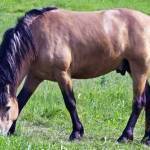Ertugliflozin for Managing Metabolic Horses

Diet and exercise do not always control insulin levels in horses and ponies with insulin dysregulation (ID) and equine metabolic syndrome (EMS). Because of this, investigations into targeted therapies continue, and a new class of drugs borrowed from human medicine called sodium glucose cotransporter-2 inhibitors (SGLT2i) holds promise for EMS horses.
Many horses maintain high insulin levels despite using research-proven dietary restrictions or treatment with metformin, increasing their risk of developing laminitis. Hyperinsulinemic-associated laminitis (HAL), the most common form of laminitis affecting today’s horses, is one of the major concerns for horses with EMS. Uncontrollable pain secondary to HAL frequently results in euthanasia.
One recent study conducted in the United States reported the benefits of the SGLT2i canagliflozin for horses with refractory laminitis and hyperinsulinemia secondary to EMS.* According to that team of veterinarians, once daily administration of canagliflozin:
- Lowered blood sugar levels;
- Corrected insulin to normal or near-normal levels;
- Reduced abnormal fats pads; and
- Eliminated pain due to laminitis.
They did, however, recommend reserving canagliflozin for horses resistant to diet and exercise modifications. Canagliflozin, however, is not available in all countries.
In the United Kingdom and Australia, the SGLT2i ertugliflozin is gaining popularity for managing hyperinsulinemia. According to another study, ertugliflozin has likely been used in hundreds of horses to date and appears quite promising based on a case series of 51 horses and ponies with persistent hyperinsulinemia.**
In this study, the two key indications for SGLT2i are:
- Horses with HAL.
“In these horses I no longer hesitate to use SGLT2i from the start. We see much faster and more consistent clinical improvements in horses that are given the drugs in addition to other laminitis treatments that I think this class of drugs is indicated to minimize the suffering associated with laminitis,” said David Rendle, B.V.Sc., M.V.M., a coauthor of the aforementioned study.
- Horses that have persistent hyperinsulinemia despite dietary management.
“I know some people think we should be able to manage all EMS and PPID cases with management alone, but the more we understand horse owner behavior the more we realize that some owners are not able to follow optimal management advice. Therefore, I use these drugs to reduce the risk of laminitis when other strategies haven’t been successful,” shared Rendle.
Medication Details: What the Buzz Is All About
Ertugliflozin is available either as a human formulation or as a paste preparation in the United Kingdom and Australia. In the United States, human formulations can be prescribed. The dose recommended by Rendle is 0.05 mg/kg by mouth once daily on an empty stomach.
“From the data I’ve seen so far, SGLT2i are effective in reducing insulin levels and laminitis risk as well as improving the recovery from laminitis,” Rendle said.
Preliminary data on ertugliflozin was presented at the 68th Annual Convention of the American Association of Equine Practitioners held in late 2022. The full study is also available online.**
Rendle relayed the following key findings after 30 days of treatment:
- Mean insulin levels 90 minutes after feeding forage significantly decreased from 224 to 59 mu/mL;
- Laminitis scores improved from 7.9 to 1.3 on the 12-point modified Obel laminitis score system;
- Body weight significantly improved; and
- No adverse clinical effects were identified, although 19% horses had polyuria and polydipsia, and serum triglyceride levels increased (but did not result in hyperlipemia) .
Rendle added, “We need more clinical data but from what we have seen so far these drugs could be a huge game-changer. But SGLT2i are no substitute for good diet and management, and it would of course be best that a horse not become obese or hyperinsulinemic in the first place!”
Diet and Exercise Before Ertugliflozin
According to Peter Huntington, B.V.Sc., M.A.C.V.Sc., director of nutrition for Kentucky Equine Research in Australia, the keys to managing ID are weight management with a combination of calorie control by diet and calorie consumption via exercise.
“ID horses should be taken off pasture and fed a measured and controlled amount of low nonstructural carbohydrate (NSC) grass hay with a low-intake balancer pellet to supply missing protein, vitamins, and minerals,” Huntington advised.
The hay may need to be soaked to reduce the nonstructural carbohydrate and energy content.
“Exercise is vital to manage ID, and it needs to be faster than a walk to increase the heart rate. If horses have painful feet after laminitis, they will be more comfortable working on sand or even swimming,” Huntington suggested.
Safety Concerns
Just like anything that seems too good to be true, there are some potential downsides to SGLT2i. In the first study, researchers relayed that this class of medication blocks the kidneys from resorbing sugar from the urine.* As a result, glucose is eliminated in urine, which can predispose the horse to urinary tract infections and excessive urination and drinking. There may also be a risk of renal failure, which can be concerning in horses treated concurrently with nonsteroidal anti-inflammatory drugs (like phenylbutazone or “bute”) or acetaminophen for managing pain associated with laminitis
Huntington said, “These new treatments are exciting developments for horses with refractory ID. But it’s early days. The drugs aren’t registered for use in horses yet, the pharmacokinetics and optimum dose haven’t been determined, and there have been no safety studies. Consider them only if nutrition and exercise don’t resolve the ID or threat of laminitis.”
*Kellon, E.M., and K.M. Gustafson. 2022. Use of the SGLT2 inhibitor canagliflozin for control of refractory equine hyperinsulinemia and laminitis. Open Veterinary Journal 12(4):511-518.
**Sundra, T., E. Kelty, and D. Rendle. 2022. Preliminary observations on the use of ertugliflozin in the management of hyperinsulinaemia and laminitis in 51 horses: A case series. Equine Veterinary Education. doi:10.1111/eve.13738.








